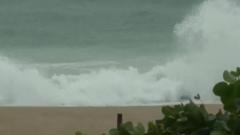As Typhoon Kajiki approaches Vietnam, the government is taking swift action to protect its citizens by mandating the evacuation of over 586,000 people. The storm, which currently boasts winds gusting up to 166 km/h (103 mph), is expected to intensify before making landfall early on Monday, according to meteorological reports.
The central provinces affected include Thanh Hoa, Quang Tri, Hue, and Da Nang, where residents have been instructed to leave their homes immediately. In preparation, numerous flights have been canceled, and maritime activities have been halted as a safety precaution.
Typhoon Kajiki has already begun to impact the region, bringing significant rainfall to Hainan, China—with forecasts suggesting totals could reach as high as 320mm (12.6 inches). Reports from BBC Weather indicate the storm will likely weaken as it moves inland in Vietnam, but still poses a serious threat, with expected wind speeds reaching up to 200 km/h and rainfall between 300 to 400mm. Furthermore, storm surges between 2 to 4 meters (6.6 to 13 feet) are anticipated.
In light of the impending threat, Vietnamese authorities have issued warnings for residents in the storm’s path to remain indoors and refrain from outdoor activities after 14:00 GMT on Sunday. The Ministry of Agriculture and Environment has flagged the situation as extremely hazardous, particularly for vulnerable structures and vehicles, including fishing vessels and tourism facilities.
In a bid to ensure public safety, soldiers have been dispatched to assist with evacuations and provide support. The impact of Typhoon Kajiki raises concerns reminiscent of the devastation caused by Typhoon Yagi last September, which tragically resulted in the loss of hundreds of lives across Southeast Asia, including 300 fatalities in Vietnam alone.
The central provinces affected include Thanh Hoa, Quang Tri, Hue, and Da Nang, where residents have been instructed to leave their homes immediately. In preparation, numerous flights have been canceled, and maritime activities have been halted as a safety precaution.
Typhoon Kajiki has already begun to impact the region, bringing significant rainfall to Hainan, China—with forecasts suggesting totals could reach as high as 320mm (12.6 inches). Reports from BBC Weather indicate the storm will likely weaken as it moves inland in Vietnam, but still poses a serious threat, with expected wind speeds reaching up to 200 km/h and rainfall between 300 to 400mm. Furthermore, storm surges between 2 to 4 meters (6.6 to 13 feet) are anticipated.
In light of the impending threat, Vietnamese authorities have issued warnings for residents in the storm’s path to remain indoors and refrain from outdoor activities after 14:00 GMT on Sunday. The Ministry of Agriculture and Environment has flagged the situation as extremely hazardous, particularly for vulnerable structures and vehicles, including fishing vessels and tourism facilities.
In a bid to ensure public safety, soldiers have been dispatched to assist with evacuations and provide support. The impact of Typhoon Kajiki raises concerns reminiscent of the devastation caused by Typhoon Yagi last September, which tragically resulted in the loss of hundreds of lives across Southeast Asia, including 300 fatalities in Vietnam alone.



















